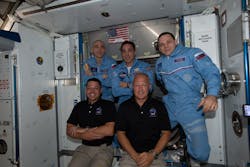Space Station astronauts get right to work on horticultural LEDs
That didn’t take long.
Three days after arriving at the International Space Station (ISS), astronauts Bob Behnken and Doug Hurley began turning their attention to one of the craft’s several LED horticultural and biological growth systems.
Behnken got things rolling on June 3 when he began eyeballing the rack-mounted Advanced Plant Habitat (APH), preparing to remove and reinstall it as part of a broader maintenance job. The next day he and Hurley indeed disassembled it, freeing up access to an ISS environmental control system which they then replaced, according to NASA blogger Catherine Williams. (Sounds similar to removing, say, a car battery to get to its headlights in an auto packed tightly under the hood).
The APH is an enclosed, automated plant growing system (see photos). Like the Space Station’s Veggie PONDS (Passive Orbital Nutrient Delivery System) module, it uses tuned LED lights to help grow edibles in space. We last reported on Veggie PONDS in March, when astronaut Jessica Meir — now back on Earth — was tinkering with it and its romaine lettuce and mizuna mustard greens.
See also: LEDs in horticulture: Philips GrowWise Center and Purdue studies space
Both systems are helping scientists better understand how to grow edible fruits and vegetables in space. While that could provide insights on improving the process terrestrially, the objective is to figure out how to use the LED systems to sustain space travelers on farther journeys into space, where delivery vehicles won’t be able to drop off freeze dried and pre-packaged meals as they do at the Space Station, a mere 220 miles high on average.
Whereas Veggie PONDs is an open chamber managed by the onboard crew and allowing them to freely reach in and snip a tasty leaf, the closed-off APH yields a harvest that astronauts freeze or chemically fix before sending it back to land for analysis. Its chamber includes cameras and over 180 sensors connected to Kennedy Space Center, which operates it remotely.
APH’s LED lights have a richer spectral content than Veggie PONDS’, with APH providing red, green, blue, and also white, far-red, and infrared (for nighttime imaging), according to NASA.
One aspect of plant growth of particular interest in the APH project is lignin, which is a natural polymer that gives structure and rigidity to plants, analogous to the role of bones in people. Botanists want to know whether lignin deteriorates in the microgravity of the Space Station. They are also studying whether less lignin might be advantageous in space by making the nutrients of plants more readily absorbed by humans, and the waste more compostable. This could lead to genetically engineering plants for less lignin.
APH has been onboard since 2018, and has been used to grow crops including dwarf wheat as well as cabbage-and-mustard-like plants in the Arabidopsis genus which includes thale cress. In addition to the tunable LED lights, APH uses a porous clay substrate and a controlled-release fertilizer to deliver water, nutrients, and oxygen to plant roots.
See also: NASA utilizes Osram LED horticultural lighting to tune recipes for plants in space
A third onboard system, called BRIC-LED, is currently using tunable LEDs to study the effect of space on plants’ immune systems. It is the latest version of the ISS’ Biological Research in Canisters (BRIC) facility, which has been used to study organisms small enough to grow in petri dishes, such as yeast and microbes.
It seems only a matter of time before Behnken and Hurley — who blasted off for the 19-hour hop to the Space Station on May 30 — turn their attention toward BRIC-LED and Veggie PONDS.
Of course, LEDs and horticulture are by no means all they and fellow ISS residents Chris Cassidy of the US and Anatoly Ivanishin and Ivan Vagner of Russia are getting up to. Over the last week, between them, they have had a look at bubbles and microfluids for oxygen production and patch-based medicine delivery systems; examined particle behavior in fluids that could improve 3-D printing processes; made observations of planet Earth; scanned the craft for radiation; swapped fuel bottles on a rack dedicated to research flame science; set up cameras for relaying video back home; and even checked the ISS’ Wi-Fi system.
With dedicated toil like that under their space belts, it seems that a heaping portion of romaine lettuce and mustard greens would be in order.
MARK HALPER is a contributing editor for LEDs Magazine, and an energy, technology, and business journalist ([email protected]m).
For up-to-the-minute LED and SSL updates, why not follow us on Twitter? You’ll find curated content and commentary, as well as information on industry events, webcasts, and surveys on our LinkedIn Company Page and our Facebook page.

Mark Halper | Contributing Editor, LEDs Magazine, and Business/Energy/Technology Journalist
Mark Halper is a freelance business, technology, and science journalist who covers everything from media moguls to subatomic particles. Halper has written from locations around the world for TIME Magazine, Fortune, Forbes, the New York Times, the Financial Times, the Guardian, CBS, Wired, and many others. A US citizen living in Britain, he cut his journalism teeth cutting and pasting copy for an English-language daily newspaper in Mexico City. Halper has a BA in history from Cornell University.






